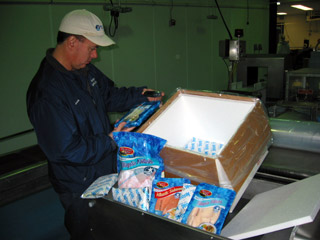Sea Star Seafood Corporation Uses MicroLite to Monitor Highly Perishable Products During Shipping
 We spoke to Robert Soares from the Sea Star Seafood Corporation about how MicroLite loggers provide the ideal solution for high maintenance products during transportation. Soares feels the minimal initial investment required by the MicroLite has been recouped repeatedly. Established in 1983, Sea Star Seafood Corporation brings a worldwide resource to retail grocery customers in case-ready solutions for frozen and refrigerated seafood sections. Sea Star Seafood markets under its own brand, Beacon Light, as well as providing customized private label programs. Sea Star continually ships highly perishable frozen seafood samples to brokers and customers across the United States. We spoke to Robert Soares from the Sea Star Seafood Corporation about how MicroLite loggers provide the ideal solution for high maintenance products during transportation. Soares feels the minimal initial investment required by the MicroLite has been recouped repeatedly. Established in 1983, Sea Star Seafood Corporation brings a worldwide resource to retail grocery customers in case-ready solutions for frozen and refrigerated seafood sections. Sea Star Seafood markets under its own brand, Beacon Light, as well as providing customized private label programs. Sea Star continually ships highly perishable frozen seafood samples to brokers and customers across the United States.
MicroLite data loggers are used to insure that the proper amount of frozen gel packs for refrigeration are used in each shipment. Too few would result in product spoilage, and too many result in excessive air freight charges. MicroLite loggers provide accurate and reliable confirmation of temperatures during shipping, and result in substantial cost savings in air freight, refrigerant packs, and product loss.
During packing of samples, a MicroLite logger is placed in the insulated shipping box with a postage-paid return envelope for its return to Sea Star after delivery. The logger is programmed to start when the courier arrives to pick up the package. Samples are recorded at 1 minute intervals during the overnight shipment. The logger is returned to Sea Star and the data is downloaded for analysis. Sea Star's requirements called for a water resistant, compact, accurate, low cost monitor, and the MicroLite met all of these points. The intuitive, easy to use MicroLab software facilitates detailed analysis of the shipment from origin to destination and allows Sea Star to optimize its shipping process. The MicroLite has paid for itself many times over in shipping and materials savings.
To learn more about Sea Star Seafood Corporation visit: www.seastarcorp.com
Food transportation and storage in Australia - Wireless Solution
In 1998 Amir Antebi from SITEST became the fourtec Australian & New Zealand Distributor.
For the food transportation and supermarket chain we recently completed a product demonstration...
The application process begins at a huge chiller, as big as a football field, with 7 loading docks on each side. They receive meat after processing. Before it is sent to supermarkets across the country it is divided up into different cuts and combinations and designated a transportation run to a different city. On arrival the cuts are again divided for delivery to the local supermarkets.
The meat's temperature throughout this process has to be constantly monitored. It cannot freeze or go above a certain temperature. The customer is experiencing problems with the current data logger because it takes 10 days to receive the data after a transportation run. This is too late and the customer is suffering large costs in spoilage because there is no way to immediately detect alarm breaches and if it was the responsibility of the transport company or at the receiving shop.
The supermarket chain was particularly attracted to the fourtec product because of the wireless and alarm features. The wireless system can place a receiver, software and Internet connection at any point on the chain. With alarms via SMS, or pager the customer knows immediately, well before the doors open, if there has been any breach in temperature level. With the alert, action can be taken and responsibility can be assigned. The downloaded data clearly shows whether the threshold level was crossed during transportation, on the dock, or in the store.
During the demonstration we set up the receiver in the customer onsite office which was in direct line of sight to the docking area. Four loggers were placed on the trucks which then left the dock and traveled in the area. We were able to receive transmission up to a range of 150m from the docking point, which was well out of line of sight. Earlier when I was evaluating the system I conducted a test to see the maximum distance I could still receive the signal. The customer was very happy with the results of the test, since for the application's need that was more than enough - data can be captured from the truck entering the parking bay, even before parking maneuvering. Currently we are in stage two, with the customer having ordered a number of units for field trial.
|

